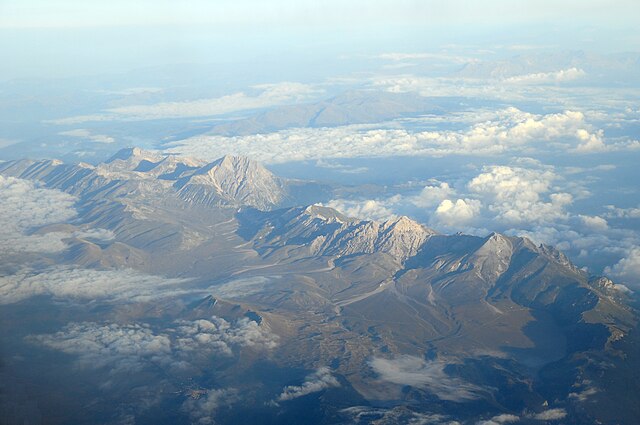Top Qs
Timeline
Chat
Perspective
Massif
Principal mass of a mountain From Wikipedia, the free encyclopedia
Remove ads
A massif (/mæˈsiːf, ˈmæsɪf/) is a principal mountain mass,[2] such as a compact portion of a mountain range, containing one or more summits (e.g. France's Massif Central). In mountaineering literature, massif is frequently used to denote the main mass of an individual mountain.
This article needs additional citations for verification. (October 2010) |

As a purely scientific term in geology, however, a "massif" is separately and more specifically defined as a section of a planet's crust that is demarcated by faults or flexures. In the movement of the crust, a massif tends to retain its internal structure while being displaced as a whole. A massif is a smaller structural unit than a tectonic plate and is considered the fourth-largest driving force in geomorphology.[3]
The word "massif" originates from French (in which the word also means "massive"), where it is used to refer to a large mountain mass or compact group of connected mountains forming an independent portion of a range. The Face on Mars is an example of an extraterrestrial massif.[4] Massifs may also form underwater, as with the Atlantis Massif.[5]
Remove ads
List
Africa
- Adrar des Ifoghas – Mali
- Aïr Massif – Niger
- Ambohiby Massif – Madagascar
- Benna Massif – Guinea
- Bongo Massif – Central African Republic
- Ennedi Plateau – Chad
- Kilimanjaro Massif – Kenya–Tanzania
- Oban Massif – Nigeria
- Marojejy Massif – Madagascar
- Mulanje Massif – Malawi
- Virunga Massif – Uganda–Rwanda–DR Congo
- Waterberg Biosphere – South Africa
Algeria
Antarctica
Asia
- Annapurna – Nepal
- Bromo-Tengger-Semeru – Indonesia
- Chu Pong Massif – Vietnam
- Dhaulagiri – Nepal
- Gasherbrum – China-Pakistan
- Kangchenjunga – Nepal–India
- Knuckles Massif – Sri Lanka
- Kondyor Massif – Russia
- Kugitangtau Ridge – Turkmenistan
- Kumgangsan – North Korea
- Logar ultrabasite massif – Afghanistan
- Mount Ararat – Turkey
- Mount Everest massif (including Lhotse) – Nepal–Tibet (China)
- Mount Kinabalu – Malaysia
- Mount Tomuraushi – Japan
- Nanga Parbat – Pakistan
India
Iran
- Dena
- Hazaran
- Kheru-Naru (Chekel)
- Kholeno
- Mount Damavand
- Sabalan
- Takht-e Suleyman Massif
- Zard-Kuh
Kazakhstan
Europe


- Aarmassif – Switzerland
- Ardennes Massif – France–Belgium–Luxembourg
- Åreskutan – Sweden
- Arlberg – Austria
- Bohemian Massif – Czech Republic
- Ceahlău Massif – Romania
- Gotthard Massif – Switzerland
- Hesperian Massif – Iberian Peninsula
- Jungfrau Massif – Switzerland
- Mangerton Mountain – Ireland
- Montgris – Spain
- Montserrat – Spain
- Mont Blanc massif – Italy–France–Switzerland
- Rhenish Massif – Germany, Belgium, Luxembourg and France
- Rila – Rhodope Massif – Bulgaria–Greece
- Troodos – Cyprus
- Untersberg – Germany–Austria
- Vitosha Massif – Bulgaria
France
- Alpilles
- Aravis Range
- Armorican Massif
- Bauges Massif
- Beaufortain Massif
- Belledonne massif
- Bornes Massif
- Calanques Massif
- Cerces Massif
- Chablais Massif
- Chartreuse Massif
- Dévoluy Mountains
- Massif des Écrins
- Jura Mountains
- Lauzière massif
- Luberon
- Massif Central
- Massif de l'Esterel
- Massif du Mercantour-Argentera
- Monte Cinto massif
- Taillefer Massif
- Queyras Massif
- Vanoise Massif
- Vercors Plateau
- Vosges Mountains
Italy
United Kingdom
- Ben Nevis massif
- Cornubian Massif
- Long Mynd
- Snowdon Massif
- Ben Klibreck
- Cairngorms massifs
North America
Canada
United States
Oceania
- Big Ben – Heard Island
- Ahipara Gumfields – New Zealand
Caribbean
- Massif de la Hotte – Haiti
- Valle Nuevo Massif – Dominican Republic
Central America
South America
- Brasilia Massif – Brazil, Argentina, Paraguay, Uruguay.
- Neblina Massif – Venezuela–Brazil
- Colombian Massif – Colombia
- North Patagonian Massif – Argentina
- Deseado Massif – Argentina
Submerged
- Atlantis Massif – part of the Mid-Atlantic Ridge in the North Atlantic Ocean
- Tamu Massif — the largest volcano on Earth
Remove ads
References
Wikiwand - on
Seamless Wikipedia browsing. On steroids.
Remove ads
